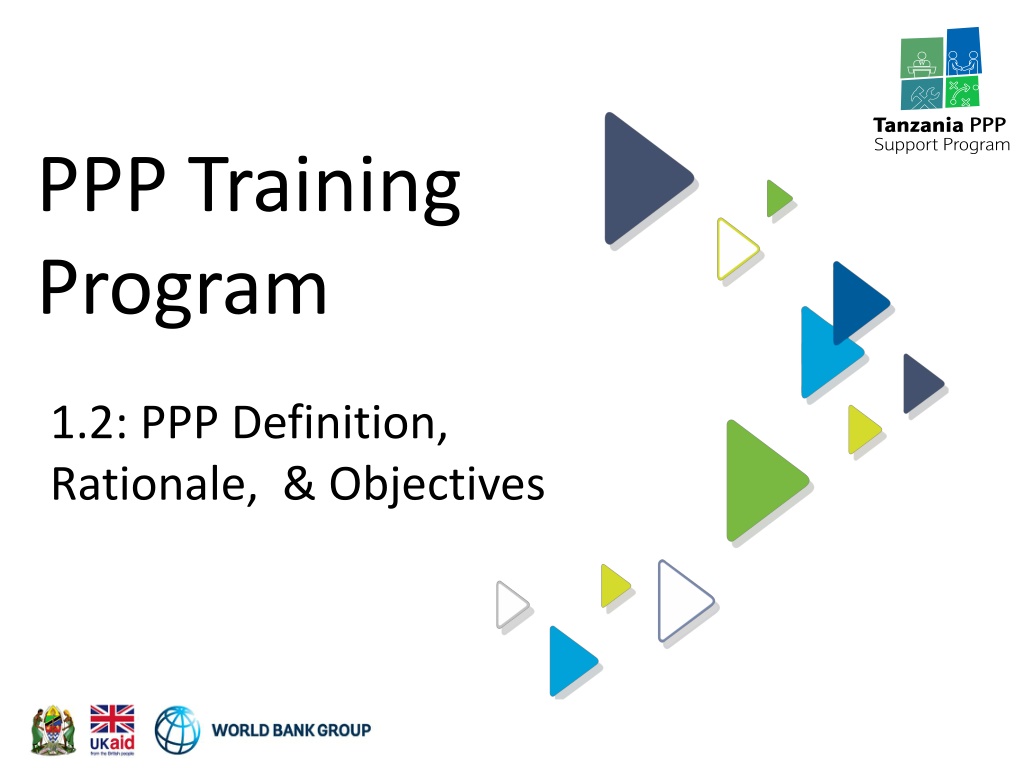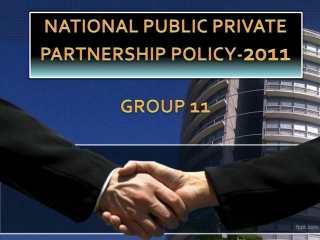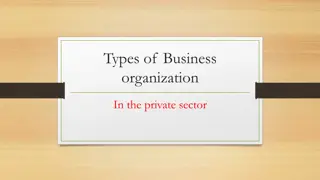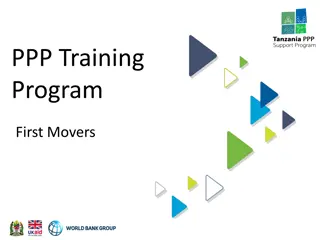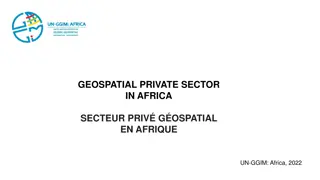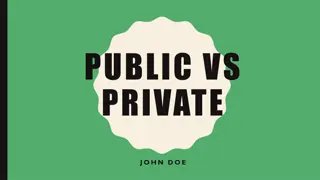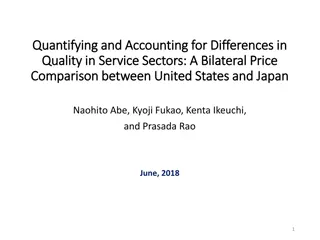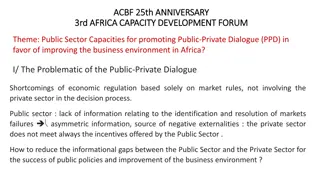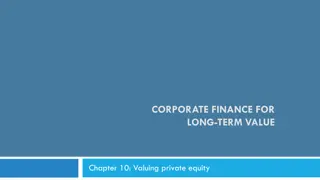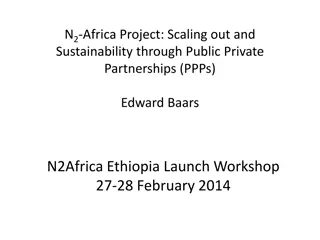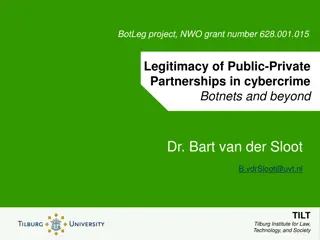Understanding Public-Private Partnerships (PPPs)
Public-Private Partnerships (PPPs) involve collaborations between public and private entities to deliver infrastructure and services. This training program delves into the definition, rationale, and objectives of PPPs, highlighting the various components, characteristics, and key considerations involved in such partnerships.
Download Presentation

Please find below an Image/Link to download the presentation.
The content on the website is provided AS IS for your information and personal use only. It may not be sold, licensed, or shared on other websites without obtaining consent from the author. Download presentation by click this link. If you encounter any issues during the download, it is possible that the publisher has removed the file from their server.
E N D
Presentation Transcript
PPP Training Program 1.2: PPP Definition, Rationale, & Objectives
Public-Private Partnerships The term public private partnership describes a range of possible relationships among public and private entities in the context of delivering infrastructure and other services. 2
What Are Public-Private Partnerships? Infrastructure Project Need Will be used in whole or in part by the general public or a public agency Public Participant National, provincial or local government Private Participant Single firm or consortium Is it a partnership? Not in the traditional legal sense More likely a joint venture or in the alternative a lease or concession arrangement 3
Components of a PPP Definition PPP Characteristics A long-term contract between a public implementing agency and a private sector company Description A PPP involves a long-term contract between the public agency and private party. The definition of long-term may depend on the jurisdiction and sector. 4
Components of a PPP Definition PPP Characteristics A long-term contract between a public implementing agency and a private sector company for a public interest project that is under the responsibility of a state agency Description A PPP involves a long-term contract between the public agency and private party. The definition of long-term may depend on the jurisdiction. PPPs are intended for the delivery of a public service, as opposed to a commercial opportunity for the private party. 5
Components of a PPP Definition PPP Characteristics A long-term contract between a public implementing agency and a private sector company for a public interest project that is under the responsibility of a state agency which transfers substantial risk to the private party Description A PPP involves a long-term contract between the public agency and private party. The definition of long-term may depend on the jurisdiction. PPPs are intended for the delivery of a public service, as opposed to a commercial opportunity for the private party. One of the key value drivers of a PPP is the transfer of substantial project risks to the private party. 6
Components of a PPP Definition PPP Characteristics A long-term contract between a public implementing agency and a private sector company for a public interest project that is under the responsibility of a state agency which transfers substantial risk to the private party Description A PPP involves a long-term contract between the public agency and private party. The definition of long-term may depend on the jurisdiction. PPPs are intended for the delivery of a public service, as opposed to a commercial opportunity for the private party. One of the key value drivers of a PPP is the transfer of substantial project risks to the private party. Even when public funding is available for the project, private financing provides value as it incentivizes performance. includes private financing 7
Components of a PPP Definition PPP Characteristics A long-term contract between a public implementing agency and a private sector company for a public interest project that is under the responsibility of a state agency which transfers substantial risk to the private party Description A PPP involves a long-term contract between the public agency and private party. The definition of long-term may depend on the jurisdiction. PPPs are intended for the delivery of a public service, as opposed to a commercial opportunity for the private party. One of the key value drivers of a PPP is the transfer of substantial project risks to the private party. Even when public funding is available for the project, private financing provides value as it incentivizes performance. A focus on the specifications of project outputs rather than project inputs is a key driver of value in PPP delivery models, coupled with performance- related payments. includes private financing and includes a focus on the specifications of project outputs rather than project inputs, with payment based on performance. 8
Simply Stated PPP are contracts between a private sector entity and a government body that call for the private partner to deliver a desired service and assume the associated risks. Government is relieved of the financial and administrative burden of providing the service Government retains its role in regulating and monitoring the performance of the private partner. 9
Tanzania PPP Definition According to the PPP Act, the key characteristics that define a PPP are a contractual arrangement between a Contracting Authority (CA) and a private sector entity, in which the private sector entity: Undertakes to perform a function of a CA for a specified period; Assumes substantial financial, technical and operation risks in connection with the performance of the CA function or use of government property; or Receives a benefit for performing the CA s function, either by way of: consideration to be paid by the Contracting Authority which derives from a revenue fund, or where the contracting authority is a central government or local government authority, from revenues of such authority; charges or fees to be collected by a private party or its agent from users or customers; or a combination of such consideration and such charges or fees. 10
Key Elements of PPPs Contract for services, not procurement of assets Output, not input, specifications Payments related to service delivery Whole life approach to design, build and operation Private sector funding to underpin risk transfer 11
Key Elements of PPPs Contracts awarded based on value for money, not lowest bid Capital or capital-equivalents provided by public and private parties Reliable, long-term commitments Flexibility in structuring contractual arrangements to best suit the economic, operational and policy goals of the parties 12
PPPs Privatization PPP does not equal privatization, contracting out, outsourcing, etc. PPPs present a framework that - while engaging the private sector - acknowledge and structure the role for government in ensuring that social obligations are met and successful sector reforms and public investments achieved. Privatization involves the sale of shares or ownership in a company or the sale of operating assets or services owned by the public sector. Privatization is most common and more widely accepted in sectors that are not traditionally considered public services, such as manufacturing, construction, etc. 13
Motivation The needs that motivate governments to enter into PPPs are to: 1. Attract private capital investment (often to either supplement public resources or release them for other public needs); 2. Increase efficiency and use available resources more effectively; 3. Reduce risks; and 4. Reform sectors through a reallocation of roles, incentives, and accountability. 14
PPP Motivation & Rationale The Main motivations to consider PPPs are: Private sector efficiency and innovation Improving project and service delivery Lack of fiscal space 15
Why Bring in a Private Partner? Private Role: Innovation, technology Project Management Design, Build Maintain, Operate Lifecycle optimization Financing Private performance that is driven by profit/risk taking can generate benefits to society Public Role: Securing the public interest Policy & planning Competitive procurement Compliance management & regulation but only when the public manages the process effectively 16
Value for Money (VfM) Better VfM means that PPP delivery of a project is more attractive than conventional public delivery from the public perspective VfM is the difference between the total life cycle cost of a traditionally procured project and the total life cycle cost of the same project procured as a PPP, both providing the same level of quality 17
PPP Value Drivers Integrated Service Provision Optimal Risk Allocation Output-based Specifications Performance- based Payments Competition 18
Policy Rationale The goal of PPPs is to improve the quality, efficiency and access to key public services and infrastructure. Some of the potential benefits of PPP include: More efficient service delivery (lower cost, higher quality, faster delivery); Better value for public s money (i.e., a better combinations of price, quality and reliability of services); Reduced public sector financing requirements; and Technology transfer. 19
PPP Revenue Availability Payments Availability Payments - Private party makes investments, operates the facility and receives a payment from the government for the services based on government established performance standards. The fee is sufficient to cover debt and provide a return on investment. Government assumes part or all of the demand risk 20
PPP Revenue User Fees User fees - PPPs relying on user fees for repayment are exposed to market risks which usually increase the cost of financing and require credit enhancements to cover the downside risks. Governments can share the market risks by offering Minimum Revenue or traffic Guarantees 21
Guiding Principles 1. Value for Money 2. Affordability 3. Commercial Viability and Bankability 4. Manageability 5. Acceptability 22
Principle 1. Value for Money Pursue PPP projects if they deliver better value-for-money (VfM) than conventional public delivery. VfM = combination of the price, quality, quantity, timeliness, risk of the PPP project. 23
Different Sources of Value for Money Increase efficiency: PPPs can contribute to increasing the cost efficiency of public infrastructure provision. 24
Different Sources of Value for Money Increase efficiency: PPPs can contribute to increasing the cost efficiency of public infrastructure provision. Enhance quality: PPPs can increase quality of service by incentivizing private sector performance. 25
Different Sources of Value for Money Increase efficiency: PPPs can contribute to increasing the cost efficiency of public infrastructure provision. Enhance quality: PPPs can increase quality of service by incentivizing private sector performance. Accelerate implementation: Introducing PPPs expands implementation capacity by mobilizing additional resources. Generate value from public assets: The private sector can unlock the commercial value of public assets. 26
Different Sources of Value for Money Increase efficiency: PPPs can contribute to increasing the cost efficiency of public infrastructure provision. Enhance quality: PPPs can increase quality of service by incentivizing private sector performance. Accelerate implementation: PPPs expand implementation capacity by mobilizing additional resources. Generate value from public assets: The private sector can unlock the commercial value of public assets. 27
Value Drivers of VfM Competitive procurement (and VfM evaluation criteria) (Output) performance based specifications Efficient risk allocation Formal, well-structured contracts Life cycle optimization Performance-based payment mechanism 28
Principle 2. Affordability PPPs are not a free lunch Affordability is the capacity to pay for the project Users Government 29
PPP Fiscal Impacts Long term commitments of the government e.g., 25 years Affordable now, and in the future? Fiscal effects of signing many long term PPP contracts Fiscal impact assessment is challenging: Short-term budgets vs long-term budget commitments Value guarantees, rights, retained risks, contingent liabilities is complex 30
Principle 3. Commercial Viability and Bankability PPP won t work if it s not: Commercially viable Bankable Private partners must be healthy and profitable for the project to succeed and deliver value 31
Bankability What makes a project bankable? Integrity of government contracts / general environment Commercially viable business case Well-prepared project, robust PPP contract Reasonable risk allocation 32
Principle 4. Manageability The PPP must be manageable for both the government and the private partner Workable Project Agreement and Monitoring / Management procedures Capacity to manage in place (public and private) Project must not be too complex to manage 33
Principle 5. Acceptability Government must ensure fairness and protect the public interest Will society accept private involvement in the project; and the PPP program itself ? Social-environmental sustainability Government remains responsible; will be held to account 34
